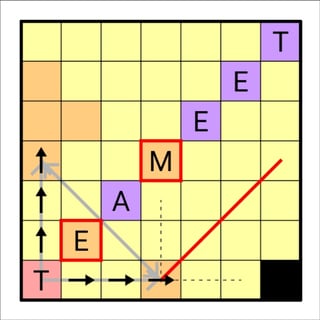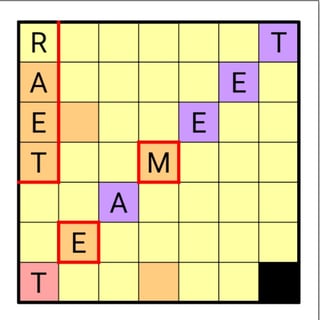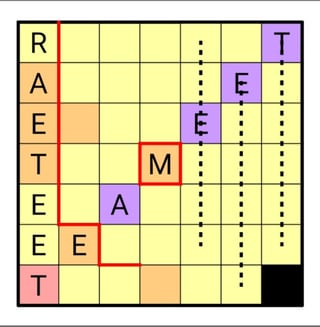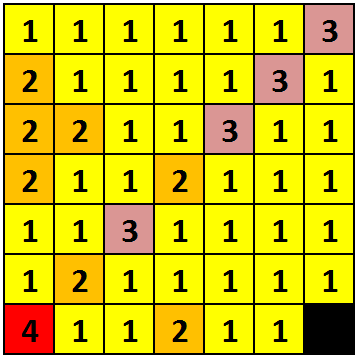An old question, bringing back to life..
Here is an answer:

which was basically found by trial-and-error method including a bit of logic.
Explanation
I will sometimes refer to columns as A,B,C,.. (from left to right), and rows as 1,2,3,.. (from top to bottom), to specify corresponding cells.
The starting point is obviously...
the bottom-left corner. Since four words overlap there, one word should contain another word within it. There are three such words: TEEM, TEAM and TEAR those contain TEE and TEA. The correct word among these cannot lie horizontally or vertically since both A6 and B7 has the value 1. Therefore it must lie along the diagonal. Thus A7 and B6 must be T and E respectively.
As middle cell can be either M or R, the word along the remaining cells of the diagonal should end with those letters i.e. one of those three words aforementioned, or could be a 3-letter word if it does not contain the middle cell; i.e. TEA or TEE. In both cases, E is the second letter (or middle letter) thus F2 should be E.

Those are the letters we can deduce logically.
(This part was already mentioned in Bob's answer. I'm repeating it here just for the completeness.)
From now on, there is no obvious logical path.
So we have to take a risk. Guess!
Assume that the middle cell is R. Then the word lying on the diagonal, starting from A7 should be TEAR (C5 cannot be E, otherwise it will give only one word). Considering the rules given by OP, one word is counted only once, therefore the other word along the diagonal should be TEE (it does not share the R).
Since we agreed to count each word only once, we will not use the same word again and again intentionally. Thus the remaining cells should be filled with words those are at least 4-letters long. Keeping that in mind, to fit the density of purple cells on the diagonal, they should be filled as in the following diagram.

Then,
there are only two possible ways to get rid of the middle cell (shown in red). But there is only one 4-letter word ending with R and it's already used.
Thus we have to give up on this route. :(
Now consider the following grid.

B6 and D4 have satisfied the condition already, therefore I will call them locked cells. In order to proceed there should be words horizontally and vertically, starting from A7. Take a look at D7. There should be two words through it. Since 3-letter word has been already used, there cannot be words along the dotted lines (horizontal/vertical). If there is a word along the red line, we can't fill the cells beneath it. Hence the other word through D7 should lie along the grey arrow (direction can be changed).
Now let's try to fill the row7.
Starting with the maximum: none of the 6-letter long words (THEYRE, TACKED, TAUGHT) seems to fit, because the letter which comes to the orange cell will be only used once in the grid, violating the criteria of that cell. (TAUGHT, written backward, also does not fit because there is no other word ending with U). And similarly 5-letter long words also do not suit. Thus it should be a 4-letter word. We have to look for the words ending with same letter. The possible candidates are TACT, TAUT, TALE and TARE. We have to choose only one from TAUT or TACT, cause if we choose both, there should be another word starting and ending with T, but we don't have any other word with that property. So I will go with TAUT, TALE and TARE (This is optional).

Now consider C5.
Only one word is left to go through it. We can't choose the horizontal or vertical paths (marked in dotted lines below) because we have to reserve space for the longer words. Therefore that word should lie along the diagonal (line marked in black). Because of 'A', the only possible candidates are TAIL and TEAR. But this is the only chance to fulfill the criterion of A3. Hence it should be TEAR.

Then,

...there must be a word along the black line, since dotted lines are not possible paths. And to fill B3, the word should be read diagonally. Now, keeping in mind that there are much longer words those haven't been used yet, we can fill those cells.

Finally, just by inspection, we can fill the rest of grid

Voila!
Thanks for reading up to this point!
Addendum
I have to tell you something.
Did you notice that we could flip or change the position of some words to get other possible answers?
Apart from that, did you notice these two extra words?

Ahhh.... this solution is not correct!
Well, OP stated that he counted one word only once, so according to the given rules this solution is acceptable.
But,
I imposed some constraints to get a unique solution.
1. Every letter in the grid should be used for words at least once.
2. If the same word appears again, you have to count that also, for instance, here you have to count TEA in both TEAM and TEAR.
3. One word can appear more than once.
These constraints do not make the puzzle difficult, but make it easy.
Now let's get back to the original puzzle.
At the beginning, we can deduce three letters in the grid logically as we've done earlier. And there is another hint. Consider the words TEAM, TEEM and TEAR. These are the only words that contains another word in it. So many of those letters are counted twice, meaning: they should lie within the caged areas below.

TEAM and TEEM should lie along the diagonal as they share the ending letter. T of TEAR is counted twice, therefore it must be placed in either of A2 or A4. But if it has to be in A2, we have to fill the 2-letters beneath it with a 2-letter word, which is impossible. Hence we have the starting cells completed as below. (There are two ways for the diagonal to be filled)

There's one more word to be placed in A5-A7. The possible solutions are TEA and TEE only. (I'll go with one solution, hopefully it will not affect the next steps)

Now consider the possible placement of the longest words.

If we allow the diagonal to be a 6-letter word, we can place only one of the other two words.

If we place two of them in the 1st row and last row, there is no space left for the other word.

If we fix one of the 6-letter words in the 7th row, there are three possible ways to fill the the other two words.



In all three cases we will not be able to fill the the grid with remaining 4-letter words. (Note that letters cannot overlap on yellow cells).
Similarly, we can inspect few other cases such as below,



...only to assure that the space is not enough for the remaining words.
Hence we can see,
unfortunately, there's no solution for this puzzle. :(























